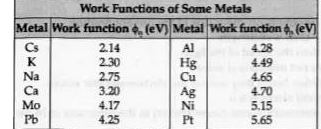TOPIC-1 PHOTOELECTRIC EFFECT (NUMERICAL PROBLEMS) from OSWAAL PUBLICATION PHYSICS (KANNADA ENGLISH) DUAL NATURE OF RADIATION AND MATTER for Class 12
| Class 12 | PHYSICS |
| Chapter | DUAL NATURE OF RADIATION AND MATTER |
| OSWAAL PUBLICATION PHYSICS (KANNADA ENGLISH) | TOPIC-1 PHOTOELECTRIC EFFECT (NUMERICAL PROBLEMS) |
| Medium | English |
| Academic Year | 2023-2024 |
Question 13
Two monochromatic radiations of frequencies v1 and v2 (v1>v2) and having the same intensity are, in turn, incident on a photosensitive surface to cause photoelectric emission. Explain, giving reason, in which case (i) more number of electrons will be emitted and (ii) the maximum kinetic energy of the emitted photoelectrons will be more.View SolutionQuestion 18
Define the terms (i) 'cut-off voltage' and (ii) threshold frequency' in relation to the phenomenon of photoelectric effect.
Using Einstein's photoelectric equation show how the cut-off voltage and threshold frequency for a given photosensitive material can be determined with the help of a suitable plot/graph.View SolutionQuestion 24
The threshold wavelength of a photosensitive metal is 662.5 nm. If this metal is irradiated with a radiation of wavelength 331.3 nm, find the maximum kinetic energy of the photoelectrons. If the wavelength of radiation is increased to 496.5 nm, calculate the change in maximum kinetic energy of the photoelectrons. (Planck's constant h=6.625×10−34 Js and speed of light in vacuum=3×108ms−1)View SolutionQuestion 25
For a metal the maximum wavelength required for photoelectron emission is 340 nm, find the work function. If the radiation of wavelength 250 nm falls on the surface of the given metal. Find the maximum kinetic energy of emitted photo electrons in eV. Given Planck's constant =6.625×10−34Js, velocity of light in vacuum is 3×108ms−1.View SolutionQuestion 26
When light of frequency 6×1014 Hz is incident on a photosensitive metal, the kinetic energy of the photoelectron ejected is 2e V. Calculate the kinetic energy of the photoelectron in eV when light to frequency 5×1014 Hz is incident on the same metal.
Given Planck's constant, h=6.625×10−34Js, 1eV=1.6×10−19.View SolutionQuestion 30
Lithium has a work function of 2.3 eV. It is exposed to light of wavelength 4.8×10−7 m. Find the maximum kinetic energy with which the electron leaves the surface. What is the longest wave length which can produce the photo electrons ?
Data : W = 2.3 eV, h=6.626×10−34Js,e=1.6×10−19C. Longest wavelength = ? , Kinetic energy = ?View SolutionQuestion 37
The wavelength of light in the visible region is about 390 nm for violet colour, about 550 nm (average wavelength) for yellowgreen colour and about 760 nm for red colour. What are the energies of photons in (eV) at the (i) violet end, (ii) average wavelength, yellow-green colour, and (iii) red end of the visible spectrum? (Take h =6.63×10−34 J s and 1 eV=1.6×10−19J.)
View SolutionQuestion 38
The wavelength of light in the visible region is about 390 nm for violet colour, about 550 nm (average wavelength) for yellow-green colour and about 760 nm for red colour.
From which of the photosensitive materials with work functions listed given below and using the results of (i), (ii) and (iü) of (a), can you build a photoelectric device that operates with visible light ?
 View Solution
View Solution
All Exercises from OSWAAL PUBLICATION PHYSICS (KANNADA ENGLISH) Class 12 PHYSICS DUAL NATURE OF RADIATION AND MATTER
- TOPIC-1 PHOTOELECTRIC EFFECT (LONG ANSWER TYPE QUESTIONS)
- TOPIC-1 PHOTOELECTRIC EFFECT (NUMERICAL PROBLEMS)
- TOPIC-1 PHOTOELECTRIC EFFECT (SHORT ANSWER TYPE QUESTIONS-I)
- TOPIC-1 PHOTOELECTRIC EFFECT (SHORT ANSWER TYPE QUESTIONS-II)
- TOPIC-1 PHOTOELECTRIC EFFECT (VERY SHORT ANSWER TYPE QUESTIONS)
- TOPIC-2 DE-BROGLIE RELATION (LONG ANSWER TYPE QUESTIONS)
- TOPIC-2 DE-BROGLIE RELATION (NUMERICAL PROBLEMS)
- TOPIC-2 DE-BROGLIE RELATION (SHORT ANSWER TYPE QUESTIONS-I)
- TOPIC-2 DE-BROGLIE RELATION (SHORT ANSWER TYPE QUESTIONS-II)
- TOPIC-2 DE-BROGLIE RELATION (VERY SHORT ANSWER TYPE QUESTIONS)
